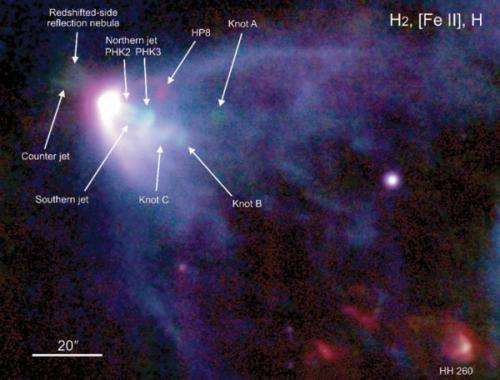A false-color image of a portion of the region around the protostar L1551 in the emission light of hydrogen and iron, with various jets and knots marked. X-ray observations suggest that strong magnetic fields in the innermost region around the young star power intense shocks. Credit: Hyashi and Pyo
(PhysOrg.com) -- A new star develops by accreting material from a circumstellar disk; both in turn are embedded in a much larger, more nearly spherical envelope of in-falling dust and gas. The protostar is obscured in the optical by the thick dust in its surroundings, although it can be detected at radio, infrared, and hard X-ray wavelengths which penetrate the material.
The young protostar rotates, and one consequence of its spin is that the star ejects bipolar jets of ionized and molecular gas. These outflows can be readily seen, and are important markers of stellar youth. However the mechanism(s) that drive these protostellar outflows - including the acceleration and the collimation processes - are poorly understood.
The most spectacular manifestations of these outflows are termed Herbig-Haro (HH) objects; they are shocked condensations in the outflows. Sometimes these knots of material are measured to have motions of hundreds of kilometers per second. In ten known cases, X-rays are also seen around these HH objects, implying that they have shock velocities over 500 kilometers per second. But this presents a puzzle: to reach such high shock velocities within the jets, models require that the material be ejected with even higher velocities - about 1000 kilometers per second - yet such high velocities have never been detected.
The protostar L1551 is one such case of X-ray emission from a bipolar jet. CfA astronomer Hans Guenther and two colleagues used the Chandra X-ray observatory to study the HH objects associated with L1551. Comparing their new measurements with older ones, they report that the X-ray emission has been constant for over a decade. Their models conclude that mass ejection from the star in the presence of strong magnetic fields around the base of the outflow can maintain a steady shock and produce the X-rays observed. The affected region is only about 10 AU in size (one astronomical unit is the average distance of the Earth from the Sun), small enough that high velocity material would be difficult to spot directly. The results not only help to explain the emission in this protostar, they help resolve the more general puzzle of X-rays from protostars.
Provided by Harvard-Smithsonian Center for Astrophysics





















